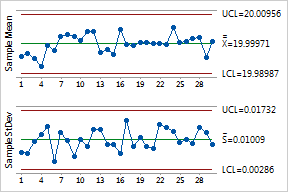
The points vary randomly around the center line and are within the control limits. No trends or patterns are shown. The variability in the fill weight of the window cleaner is stable across the 30 subgroups.
Plots the process mean (Xbar chart) and process standard deviation (S chart) over time for variables data in subgroups. This combination control chart is widely used to examine the stability of processes in many industries. For example, you can use Xbar-S charts to examine the process mean and variation for subgroups of part lengths, call times, or hospital patients' blood pressure over time.
The Xbar and S chart are displayed together because you should interpret both charts to determine if your process is stable. Examine the S chart first. The process variation must be in control to correctly interpret the Xbar chart because the control limits of the Xbar chart are calculated considering both process spread and center. If the S is out of control, then the control limits on the Xbar chart may be inaccurate and may falsely indicate an out-of-control condition.
Consider the below Xbar-S chart. A household product manufacturer wants to assess the stability of its filling process for a window cleaning product. They sample ten window cleaner bottles every hour for 30 hours and weigh each of them.
|
|
The points vary randomly around the center line and are within the control limits. No trends or patterns are shown. The variability in the fill weight of the window cleaner is stable across the 30 subgroups.
|
Use the Xbar-S chart when your subgroup size is nine or more. Use the Xbar-R chart when your subgroup size is eight or less.